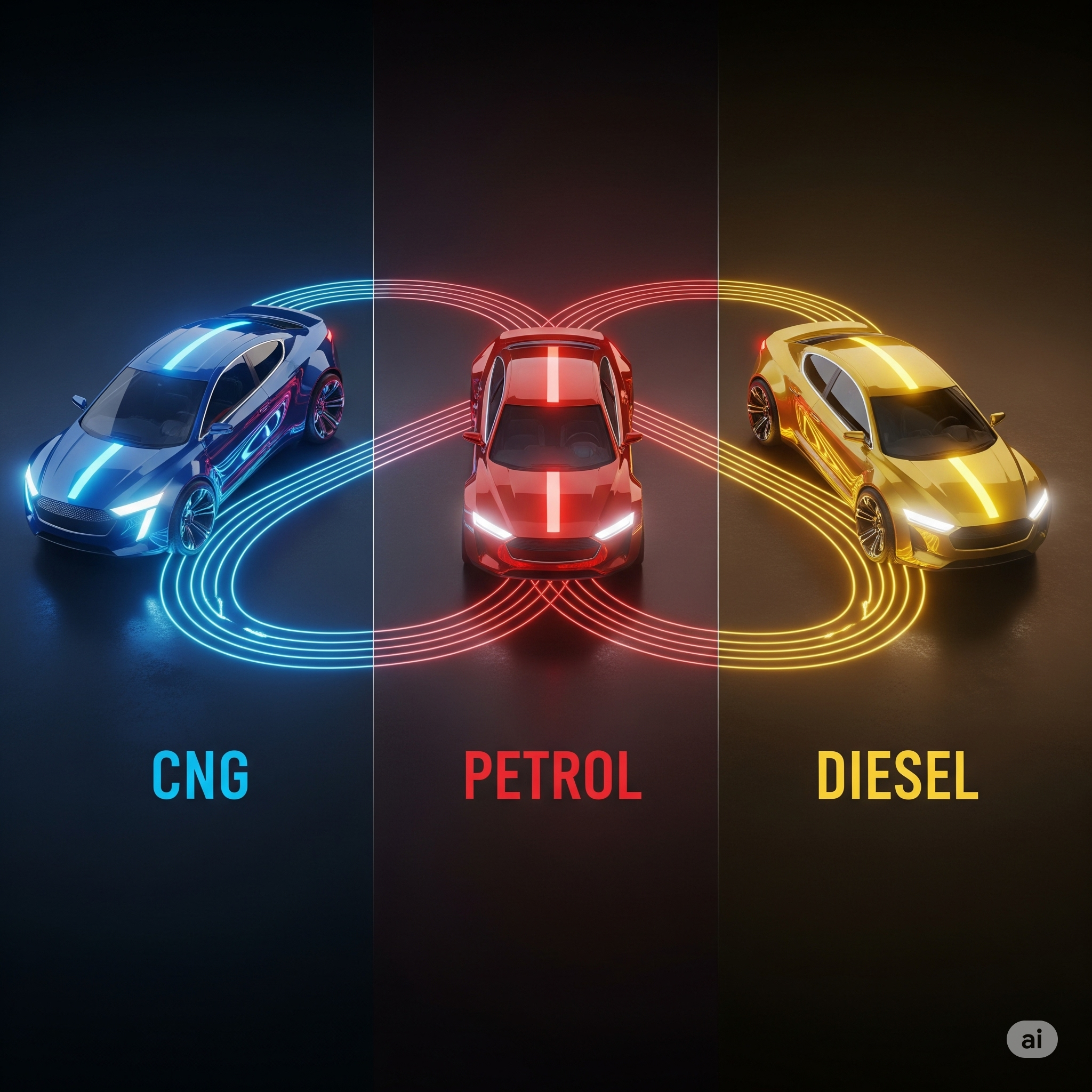The automotive fuel landscape has evolved significantly over the years. As the world grapples with environmental concerns, rising fuel costs, and technological advancements, choosing the right fuel for vehicles has become more crucial than ever. Compressed Natural Gas (CNG), petrol, and diesel are the three most widely used fuels in India and several other countries. Each fuel type comes with its unique set of advantages and disadvantages in terms of cost, environmental impact, and vehicle performance. This study provides an in-depth comparative analysis to help understand the nuances of each fuel type.
1. Understanding the Fuels
1.1 Petrol (Gasoline)
Petrol, also known as gasoline, is a liquid fuel derived from crude oil. It is widely used in internal combustion engines, particularly in cars and motorcycles. Petrol engines operate on the principle of spark-ignition, where fuel is ignited by a spark to produce energy. Its high volatility makes it suitable for quick combustion, enabling smooth acceleration and high-speed performance.
1.2 Diesel
Diesel is another liquid fuel obtained from crude oil but differs from petrol in its chemical composition. Diesel engines use compression-ignition, where air is compressed to a high temperature, causing diesel to ignite spontaneously. Diesel is known for higher energy density, which makes diesel vehicles fuel-efficient and ideal for heavy vehicles and long-distance travel.
1.3 Compressed Natural Gas (CNG)
CNG is primarily composed of methane (CH₄) and is stored at high pressure. It is a cleaner alternative to conventional fuels, gaining popularity in urban transport and light commercial vehicles. CNG operates in modified internal combustion engines similar to petrol engines but with different injection systems. It is considered eco-friendly due to lower emissions of greenhouse gases and pollutants.
2. Cost Analysis
2.1 Fuel Price Comparison
Fuel cost is a critical factor influencing consumer choice. As of 2025 in India, approximate fuel prices are:
- Petrol: ₹95–₹105 per liter
- Diesel: ₹85–₹95 per liter
- CNG: ₹60–₹75 per kg
From the above, it is clear that CNG is the most economical fuel per unit of energy, followed by diesel and petrol.
2.2 Running Cost
The running cost of a vehicle depends not only on fuel price but also on fuel efficiency:
- Petrol Vehicles: Average mileage of 12–18 km/liter. Running cost is higher due to both fuel price and lower fuel efficiency compared to diesel.
- Diesel Vehicles: Mileage averages 15–22 km/liter. Diesel engines offer longer range per liter, reducing cost per kilometer.
- CNG Vehicles: Mileage ranges from 18–25 km/kg. Even though initial conversion or vehicle cost is higher, the cost per kilometer is the lowest among the three fuels.
2.3 Maintenance Cost
Maintenance plays a vital role in overall cost:
- Petrol: Relatively cheaper maintenance; spark plugs, carburetor, and ignition system require periodic servicing.
- Diesel: Higher maintenance cost due to fuel injectors, turbochargers, and engine durability requirements.
- CNG: Engines need special care; valves and fuel injectors may wear faster. Regular inspections of high-pressure gas cylinders are mandatory for safety.
3. Environmental Impact
3.1 Emissions Overview
Air pollution and greenhouse gas emissions are major concerns for urban environments. Here is a comparative view:
| Fuel | CO₂ Emissions | Particulate Matter | NOx Emissions | Other Pollutants |
|---|---|---|---|---|
| Petrol | Moderate | Low | Moderate | Hydrocarbons |
| Diesel | High | High | High | SO₂, Black Smoke |
| CNG | Low | Very Low | Low | Negligible |
CNG stands out as the cleanest fuel, producing significantly fewer pollutants and greenhouse gases. Diesel, while energy-efficient, emits more particulates and NOx, contributing to smog and respiratory issues. Petrol lies in between, offering cleaner emissions than diesel but higher than CNG.
3.2 Environmental Regulations
Stringent regulations have influenced fuel technology:
- Petrol & Diesel: Bharat Stage VI (BS6) emission standards in India have reduced harmful emissions significantly by introducing cleaner engines and fuel formulations.
- CNG: Already compliant with most emission standards due to its inherently cleaner combustion. Many urban areas, such as Delhi, have mandated CNG for public transport to reduce air pollution.
3.3 Carbon Footprint
A vehicle’s carbon footprint is linked to fuel type, efficiency, and distance traveled:
- CNG vehicles produce 20–30% less CO₂ compared to petrol and 25–40% less than diesel per kilometer.
- Diesel engines, though more fuel-efficient, emit more carbon per liter than CNG.
- Petrol vehicles emit intermediate levels of carbon but are generally less polluting than diesel.
4. Performance Comparison
4.1 Engine Power and Torque
Performance is often a decisive factor for users:
- Petrol Engines: Provide higher revving power, smoother acceleration, and better responsiveness. Ideal for urban commuting and lighter vehicles.
- Diesel Engines: Offer higher torque at lower RPM, making them suitable for heavy vehicles, SUVs, and long-distance travel. Acceleration may be slower, but towing capacity is superior.
- CNG Engines: Slightly lower power output compared to petrol due to lower energy content. Acceleration can feel less responsive, but modern CNG engines have minimized this difference.
4.2 Engine Longevity
Engine life varies across fuel types:
- Petrol: Shorter engine life compared to diesel but lower stress on engine components.
- Diesel: Durable and robust engines that can last longer with proper maintenance. Ideal for high-mileage usage.
- CNG: Engine life can be comparable to petrol if maintained properly. However, prolonged use without timely maintenance can lead to valve seat wear and fuel system issues.
4.3 Refueling Convenience
Availability of fuel impacts convenience:
- Petrol & Diesel: Widely available at fuel stations across urban and rural areas.
- CNG: Limited to specific urban centers and some highways. Expansion is ongoing, but rural availability remains low. CNG vehicles may require dual-fuel systems (petrol+CNG) for flexibility.
5. Safety Considerations
5.1 Flammability and Storage
- Petrol: Highly flammable and poses fire risks during accidents.
- Diesel: Less flammable than petrol but produces dense smoke if ignited.
- CNG: Stored under high pressure; while it disperses quickly in case of leaks, cylinder rupture can be hazardous. Regular inspections are crucial.
5.2 Accidents and Impact
- Petrol vehicles may catch fire more easily in accidents.
- Diesel vehicles emit toxic fumes in case of leaks.
- CNG vehicles, when maintained properly, are generally safe; modern cylinders are tested to withstand extreme pressure.
6. Adoption Trends
6.1 Market Trends
Global and Indian automotive markets show varied adoption:
- Petrol: Remains dominant in small cars and motorcycles due to smooth operation and widespread availability.
- Diesel: Preferred for commercial vehicles, SUVs, and long-distance travel due to fuel efficiency and high torque. However, rising emission concerns and taxes are limiting diesel adoption.
- CNG: Growing in public transport and fleet vehicles. Government incentives and lower running costs encourage adoption, especially in metro cities.
6.2 Government Policies
- Subsidies and incentives for CNG vehicles promote cleaner air.
- Petrol and diesel face higher taxation to discourage pollution and fund environmental initiatives.
- BS6 regulations have pushed manufacturers to develop cleaner petrol and diesel engines.
7. Comparative Summary
| Aspect | Petrol | Diesel | CNG |
|---|---|---|---|
| Fuel Cost | High | Moderate | Low |
| Mileage | Moderate | High | High |
| Engine Power | High | Moderate Torque | Moderate |
| Maintenance | Low | High | Moderate |
| CO₂ Emissions | Moderate | High | Low |
| Particulate Emissions | Low | High | Very Low |
| Availability | High | High | Limited |
| Safety | Flammable | Less Flammable | High Pressure Cylinder |
| Ideal Use | Urban commuting | Long-distance & heavy vehicles | City transport, environment-friendly use |
From the table, it is evident that CNG is the most eco-friendly and cost-effective fuel, especially for urban commuting. Diesel excels in efficiency and torque, suitable for long-distance and heavy-duty usage. Petrol offers smooth performance and widespread availability, ideal for personal urban vehicles.
8. Future Outlook
8.1 Electric Vehicles vs Conventional Fuels
While CNG, petrol, and diesel remain dominant, the rise of electric vehicles (EVs) is shifting the landscape. EVs offer zero emissions at the point of use, though grid electricity sources may still contribute to carbon footprint. Governments are promoting EV adoption alongside CNG to reduce urban pollution.
8.2 Technological Advancements
- Petrol and Diesel: Improvements in engine efficiency, turbocharging, hybrid systems, and emission control technologies.
- CNG: Better storage technologies, dual-fuel systems, and lighter cylinders are improving performance and convenience.
- Alternative Fuels: Hydrogen fuel cells and biofuels may complement or replace traditional fuels in the long term.
9. Conclusion
Choosing between CNG, petrol, and diesel depends on multiple factors including cost, environmental impact, performance, and availability. For city driving with an emphasis on eco-friendliness and affordability, CNG is increasingly becoming the preferred choice. Diesel remains the fuel of choice for heavy vehicles and long-distance travel due to its torque and efficiency advantages. Petrol offers a balance between performance and convenience, suitable for urban commuters seeking smooth driving experiences.
In conclusion, an informed choice requires evaluating individual requirements, environmental considerations, and financial constraints. As technology advances, the future may see a hybrid scenario where CNG, conventional fuels, and electric vehicles coexist, offering sustainable mobility options for different users.




